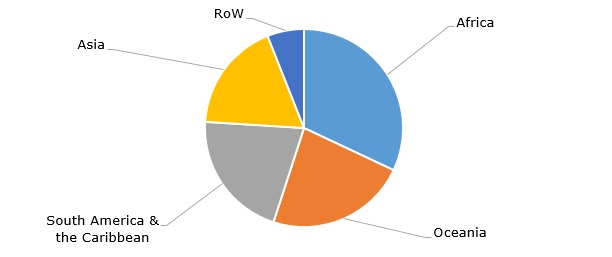World’s Leading Bauxite Mining Countries
21 Nov 2018 • by Natalie Aster

LONDON – To date, bauxite is the most important source of aluminum: around 85% of the world’s total bauxites production go for the production of alumina with the use of a wet chemical caustic method widely known as the Bayer process; further, the bulk chunk of the produced alumina is employed as the raw material for the production of aluminum metal and alloys.
Bauxite is a heterogeneous, sedimentary material which is composed primarily of 1 or more aluminum hydroxide minerals (biggsite, diaspore, boehmite, etc.) and different mixtures of silica, titania, iron oxide, aluminosilicate, clays, and some other impurities in small or trace amounts.
This mineral is widely occurring across the globe, with the largest deposits in tropical areas. The world’s total bauxite reserves are estimated at nearly 55-75 billion metric tons (BMT). Geographically, Africa commands the biggest share of the global bauxite reserves – appr. 32%, it is followed by Oceania, and South America & the Caribbean with shares of around 23% and 21%, respectively.
Bauxite: structure of global reserves by region, 2017

According to a broad assessment of geological potential, bauxite mineralisation is quite common all over the world. However, the world’s known bauxite reserves are concentrated in only 13 countries. Moreover, five countries (namely Guinea, Australia, Brazil, Vietnam, and Jamaica) account for more than 70% of the world’s total bauxite deposits volume.
Guinea boasts the most abundant deposits of bauxites in the world – about 7.4 BMT. The country’s bauxites are recognised for high alumina content. The main bauxites concentration areas in Guinea include Lower Kindiaand Boke, Upper Dabola, Central Labe, and Gaoual.
The second largest bauxites reserves are found in Australia – around 6 BMT. The biggest deposits in Australia occur in such regions as the Gulf of Carpentaria, Mitchell Plateau & Cape Bougainville, and the Darling Scarp.
Vietnam has the third largest deposits of bauxites in the world – estimated at about 3.7 BMT. Bauxites in the country are mainly distributed in such central and southern provinces as in DakNong, DakLak, Lam Dong, and Kon Tum.
Countries with the biggest bauxite reserves, 2017 (in BMT)
.jpg)
The global bauxite production demonstrated moderate fluctuations during the past 5 years. In 2016, it experienced a slight decline and totaled some 270 million metric tons (MMT). However, in 2017, the world’s production of bauxites registered healthy growth and reached around 300 MMT.
World production volume of bauxites during 2011-2017 (in MMT)
.jpg)
The growth of the global bauxite production is slated to remain relatively high in the years ahead owing to the anticipated launch of new projects and expansion of the existing ones in Australia, Indonesia, India, Guinea, and other producing countries.
At present, the top 5 bauxites producing countries together command a share of about 86% of the world’s total bauxites output.
Top 5 Bauxite Mining Countries in the World:
5. INDIA
India produced nearly 27 MMT of bauxites in the past year accounting for appr. 9% of the world’s total output. This country holds the 9th biggest bauxite reserves estimated at about 830 MMT. Bauxite reserves in India are mostly concentrated in such states as Andhra Pradesh and Orissa. Orissa alone contributes one-third of the Indian total bauxite output.
Panchpatmali mine is the biggest bauxite producer in the country – its production capacity is estimated at around 6.3 MMT. This mine is owned and operated by the state-owned company National Aluminium Company (Nalco). The second biggest bauxite mine in India is Baphlimali mine; it is located in Orissa, operated by Hindalco and has a production capacity of appr. 4.5 MMT. India’s third biggest bauxite mine is Kolhapur bauxite mine with a production capacity of nearly 2.3 MMT.
India’s bauxite production during 2011-2017 (in MMT)
.jpg)
India’s bauxite production is predicted to continue growing in the years ahead and climb to 30.9 MMT by the end of this year, and reach around 50.7 MMT by the year 2027. The mounting domestic consumption and favourable government policies are likely to act as the major growth drivers of the country’s bauxites output. However, increasing tribal tensions and tightening environmental regulations pose downside risks for the domestic bauxite market, by slowing down novel projects.
4. BRAZIL
With a production volume of 36 MMT in 2017, Brazil is the fourth leading bauxite producer across the world. The country contributes about 12% of the global bauxites output. Brazil’s resources of bauxites are estimated at some 2.6 BMT – it is the fourth largest bauxite resources across the globe.
The biggest bauxite mine in the country is the Porto Trombetas mine – it is owned and operated by Mineração Rio do Norte (MRN). The production capacity of this mine is around 18 MMT. It is followed by Vale’s Paragominas mine and Alcoa’s Juruti mine with production capacities of 5.4 MMT and 2.6 MMT, respectively.
Brazil’s bauxite production during 2011-2017 (in MMT)
.jpg)
3. GUINEA
A rapid-growing bauxite producer, Guinea takes the third place in the world in terms of bauxites production. This West African country is responsible for nearly 15% of the global bauxites output. Last year, Guinea produced some 45 MMT of bauxites. The country possesses the largest bauxite reserves from pole to pole – over 26% of the world’s total.
The Sangaredi mine (a.k.a. the Boke mine) is the biggest bauxite mine in Guinea. It is operated by the country’s dominant bauxite producing company – Compagnie des Bauxites de Guinea (CBG), which is a joint venture between Guinea’s Halco Mining (51%) and government (49%). The annual capacity of this mine is more than 14 MMT.
Guinea’s bauxite production during 2011-2017 (in MMT)
.jpg)
Spurred by the entry of new industrial players into the bauxite production in the country along with the growing investments and rising production capacity of the current players, the Guinean bauxite production capacity is slated to amount to 53.3 MMT by the end of the current year and surge to 78.2 MMT in the year 2027. The ultimate goal of the Guinean bauxite industry is to reach the annual bauxite output volume of 100 MMT.
To date, Guinea holds the second largest number of new bauxite projects around the world. The project pipeline acts as the key driver of the Guinean bauxite industry. The most prominent projects include France's Alliance Minière Responsible (AMR) and the Société Minière de Boke (targeted at the exploitation of a deposit near the Boke region containing approximately 430 MMT of bauxites), and Alufer Mining’s Bel Air project (that is poised to produce some 5.5 MMT of bauxites annually and, further, come up to 10 MMT per year in the next 15 years).
With numerous projects in the development phase expected to move into production soon and largely u
ntapped bauxite deposits presenting significant opportunities for mining companies, Guinea is poised to emerge as the global leader in bauxite production in the near future.
2. CHINA
China ranks the second leading producer of bauxites. The country’s bauxite output totaled some 68 MMT in 2017 – it is equivalent to over 22.6% of the world’s total production volume. Besides, China is the dominant consumer of bauxites globally.
China’s bauxite reserves, estimated at around 1 BMT, are the world’s sixth-biggest and mostly concentrated in four provinces - Guizhou, Henan, Guangxi, and Shanxi. China’s biggest bauxite mine, Jiakou mine situated in Shanxi province, has the annual production capacity of about 6.4 MMT. It is followed by the xiaoyi-xingan and the xiaoyi-shaoy mines both situated in Shanxi province with production capacities of 6 MMT and 5.9 MMT, respectively. The leading bauxite producer in China is the Aluminium Corporation of China (a.k.a. Chinalco).
China’s bauxite production during 2011-2017 (in MMT)
.jpg)
1. AUSTRALIA
Australia tops the list of the global leading bauxite producers. Last year, Australia produced around 83 MMT of bauxites, thus, contributing more than 27.6% to the world’s total output.
The country possesses the second richest bauxite deposits around the globe. There are five large bauxite mines in Australia: the Boddington mine controlled by BHP Billiton, the Huntly and Willowdale mines owned by Alcoa, the Weipa mine in Queensland owned by Rio Tinto Alcan, and the Gove mine controlled by Rio Tinto’s subsidiary – Pacific Aluminium.
Australia’s bauxite production during 2011-2017 (in MMT)
.jpg)
The production of bauxites in Australia is projected to maintain sustainable growth in the coming years propelled by stable activity at some 40 projects hosted in the country. The growth will be considerably fueled by expansion of Rio Tinto’s Weipa mine located in Queensland. This mine together with the Gove mine spurred the upturn of the company’s bauxite production in 2017, reaching nearly 50.8mnt. Besides, Rio is developing its USD 1.9 billion Amrun project, that is set to beef up mining activities in the south part of the Embley River, between Aurukun and Weipa. This project will be put on stream in 2019, and initially its annual production capacity will be around 22.8 MMT. Another major driver of the Australian bauxite production growth is the Urquhart bauxite project in North Queensland operated by Metallica Minerals; this project will be soon started up as the company has already obtained a mining lease from the government.
© MarketPublishers.com, 2018
Analytics & News
